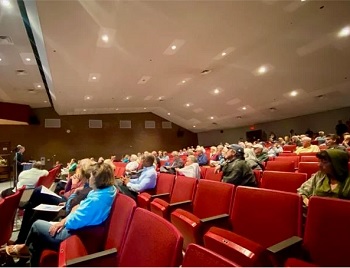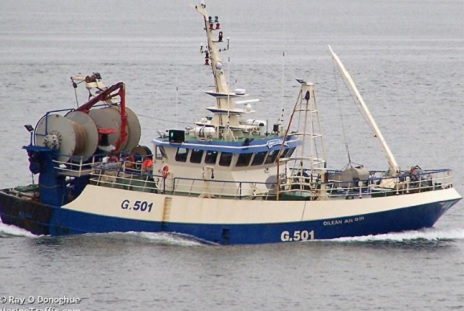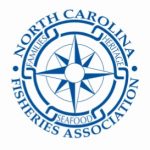Tag Archives: commercial fishing
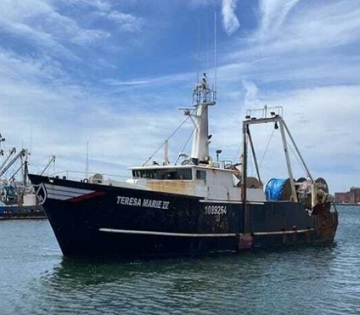
Environmental Regulations and Wind Turbines Are Backing New England Fishermen into a Corner
Just three weeks ago, Jerry Leeman was a commercial fishing captain in New England and a very successful one at that. Now, as executive director of the newly formed New England Fishermen Stewardship Association, he’s leading the charge against Biden administration policies that threaten the industry he loves, including overregulation and wind-turbine development in the Gulf of Maine. Leeman said that he and fellow New England fishermen have serious concerns about the accuracy of the NOAA data. Fish-population assessments fell to the wayside during the Covid years — 2021 and 2022 — and the data-collection process has not yet been corrected. “Whether you’re a lobsterman or a ground fisherman, a trend up and down the coast here is that nobody wants wind turbines placed in our environment. It’s going to mess up our stocks and our species. Not to mention it’s going to change the viability for generations to come in the fishing grounds,” Leeman said. Photos, >click to read< 07:51
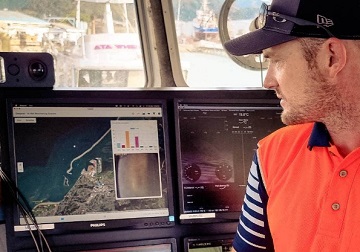
Fishing tech all set to net the catch of the day and nothing else
Dom Talijancich has every available sensor technology on board his 24-meter trawler, FV Mako. Everything but a camera and AI system that identifies what type of species are entering his net during a tow. If the technology were available, the Nelson fisherman and businessman would have got it immediately. But there was gap in the market for a piece of equipment like that, and it led him to developing his own company and the technology to do the job. Talijancich’s tech company Advanced Conservation Solutions (ACS) have tech that can improve the sustainability of commercial fishing using artificial intelligence (AI). >click to read< 08:53

Profitable Port of New Bedford draws IRS scrutiny of tax evading fishermen
As the nation’s number one commercial fishing port, New Bedford is very much on the radar. “The statistics we have cover the six New England states but really the fishing industry is significant in Rhode Island, Maine and Massachusetts, with, of course, New Bedford being the most valuable port not only in New England but in the United States,” said IRS Criminal Investigation Supervisory Special Agent Matthew Amsden. Seven New England fishermen, including three from New Bedford and one from Fall River, were charged last month with tax evasion and failing to file returns. The other three indicted were from Rhode Island, according to a press release from the IRS Criminal Investigation unit. >click to read< 07:40

Tornados Make Bering Sea Debut
Seattle trawler Storm Petrel has finished its first trips using a pair of Tornado pelagic trawl doors from Vónin, and skipper Acácio DoMar has been impressed with how the new doors have handled. ‘They tow well, square well and shoot away well. They’re a great fit to what we do,’ he said, as the A-season for Alaska pollock was coming to an end. This is the 37-metre Storm Petrel’s main fishery. ‘We fish pollock for most of the year. There’s some codfish, but it’s a small season.’ The company did its homework ahead of investing in new doors, with Acácio DoMar’s fellow captain and fleet manager Dan Martin travelling to Scotland and other places to check out the latest technology. Photos, >click to read< 18:01

From Wheatley: Voyage to the bottom of the sea (Part 1)
I came to be speaking with Doug Johnston in the net repair room of Johnston Net and Twine, the shop, on County Road 3 on the east side of Wheatley, that Doug co-owns with his son, Rob. Doug has been in the Lake Erie commercial fishing industry for 67 of his 79 years. Of those, Doug was on Lake Erie for 34 years, and for about four years on Lake Huron, as a deckhand, and then captain and boat owner. To this day, he co-owns, with his son Rob, the Dorothy J – a 68-foot, 300-horsepower Lake Erie fish tug built in 1957 at Dunnville on the Grand River.Like most people who make their living in the commercial fishing industry, Doug has seen a lot of things: years when fish were plentiful, years when it seemed they had vanished; spectacular sunrises on smooth-as-glass water; and terrifying storms and fellow-fishermen lost and rescued. >click to read< 10:06

Democrats’ Green Agenda Will Gut America’s Oldest Industry And Turn Coastal Towns Into The New Appalachia
Biden’s regulators are driving fishermen of all kinds off the water in droves, while offshore wind development his administration backs is threatening access to productive fishing grounds. Coastal towns keyed to commercial fishing—like Stonington, Maine or Grand Isle, Louisiana—are facing social and economic oblivion. Fishermen are not a powerful political constituency. They do not give lavishly to politicians or command a powerful lobby in Washington. Of late, fishermen in the north Atlantic formed a grassroots organization, the New England Fishermen Stewardship Association (NEFSA), to advocate for jobs, coastal communities, and sustainable management of our oceans. >click to read< 13:35

Big changes are coming to Cordova’s south harbor
Long overdue renovation of Cordova’s south harbor begins this fall, with a schedule that sets completion of the $40 million project in the spring of 2024. The project is under contract with Turnagain Marine Construction, an Anchorage firm that specializes in heavy civil marine construction, said Tony Schinella, who has served as harbormaster at Cordova for about a decade. “We are definitely excited,” said Schinella. “We’re well overdue for a facelift. The existing docks have been there about 40 years.” The revamp, initially expected to cost about $30 million,,, >click to read< 16:50

For Whales and Crabbers, Finding Balance Is Getting Harder
In Dick Ogg’s 25 years of commercial fishing, he’s had a few close encounters with whales—mostly while pulling Dungeness crab pots off the ocean floor. “I’ve had whales right next to me,” within about five meters, says Ogg. “They follow me, they watch, they’re curious. And then they go on about their business.” Ogg is fortunate his interactions have been so leisurely. For nearly a decade, California’s whales and crabbers have been locked in a persistent struggle. From 1985 to 2014, the National Oceanic and Atmospheric Administration (NOAA) reported an average of 10 whales were entangled in fishing gear each year along the west coast of the United States. >click to read< 07:53

Alaska officials prepare for possible commercial fishing expansion into Arctic waters
Bans on commercial fishing in U.S. and international Arctic waters have been lauded as admirable preemptive actions that protect vulnerable resources before they are damaged by exploitation. But now the Alaska Department of Fish and Game is preparing for a time when the 14-year-old moratorium on commercial fishing in federal Arctic waters is lifted. The department is seeking $1 million in state general funds and another $2 million in federal funds to work on research to better understand those Arctic waters in the event that commercial fisheries are conducted there, Fish and Game Commissioner Doug Vincent-Lang said on Wednesday. >click to read< 12:42

Few benefits seen from close-to-shore wind turbines
It’s beyond offensive for Gov. Phil Murphy to dismiss as “disinformation” the concerns of many of his constituents about a possible connection between wind energy survey work and the almost weekly occurrence of dead whales floating onto the Jersey Shore. Here are some things the governor has repeatedly failed to address: The planned wind farms, particularly those off of Long Beach Island, will have structures up to 1,000 feet tall, and will be close enough to land to be visible from beaches. For the Atlantic Shore project, they will be as few as 9 miles offshore. These hundreds of turbines proposed for three installations could bring devastating results to the state’s commercial fishing and tourism industries. >click to read< 09:19

Part II: F/V St. Jude – A Taste for Tuna
Joe Malley has reeled in a lot of different fish in his over 40-year commercial fishing career, but tuna has a special place in his heart. And on his plate. “When I’m fishing halibut, the last thing I want to see on my plate is halibut,” he said. “If I’m fishing salmon, I don’t want even a beautiful King salmon. But when I’m fishing tuna, you can serve it to me all day, every day.” Tuna doesn’t have a big statement to make, Malley said. “It’s the perfect American fish – odorless, colorless, and tasteless. And tuna can be incorporated into dishes in so many ways; for instance, you can stir fry it just like chicken. ”For Malley, his wife Joyce, and their five-person crew, tuna is a way of life. The F/V St. Jude crew spends 12 months a year on a quest for albacore tuna — from the North Pacific in summer to the South Pacific in fall. >click to read< 12:37

The Adventure of an Unconventional Career
Joe Malley keeps a faded but well-loved copy of the December 1, 1999 edition of the Magnolia News as a reminder of his family’s commercial fishing journey over the last two-plus decades. The photo and headline above the fold features Malley, his wife Joyce, and their young son Liam (now 24) standing in front of their new (at the time) fishing vessel, moored at the Port of Seattle’s Fishermen’s Terminal, as they prepared to embark on a new journey. The St. Jude, a 95-foot-troller, still makes its home at Fishermen’s Terminal today. Some things haven’t changed in the 23 years since the Magnolia News article was written. The St. Jude crew still fishes 12 months a year, chasing Albacore tuna from the North Pacific in summer to the South Pacific in fall. In between journeys they sell their catch off the St. Jude at Fishermen’s Terminal. >Photos, Video, click to read< 09:17

Storm clouds gather over local crabbing fleet
The morning was frozen, clear and calm, far better than many “dump days.” Sunday marked a first chance to start making some money after two months stuck in port. Most crabbers wouldn’t have been to bed overnight before placing their first pots. Some squeeze in more dump runs before Wednesday morning, Feb. 1, when a nearly nonstop frenzy of harvest and delivery will commence and last for weeks. With little or no sleep leading to exhaustion, the Dungeness fishery off Washington and Oregon is among the most dangerous jobs in the country. Winter weather and ocean conditions can be crazy. Fatalities are all too common, while crabbers barely bother mentioning all the back injuries, damaged fingers and a litany of other mishaps. Even so, there are plenty of local guys who don’t want it any other way. They see risk as the price of freedom. >click to read< 07:48

New monitoring rules for Northeast fishermen
Changes to U.S. rules about the monitoring of Northeast commercial fishing activities are going into effect this month with a goal of providing more accurate information about some of the nation’s oldest fisheries. The U.S. mandates observers to work onboard fishing boats to collect data and make sure fishermen adhere to rules and quotas. The National Marine Fisheries Service has adopted new monitoring rules for Northeast fishermen of groundfish, like haddock and flounder, to try to improve the accuracy of the data. >click to read< 11:57

Transportation Safety Board calls for greater attention to safety in commercial fishing
The Transportation Safety Board of Canada is calling for greater attention to safety on commercial fishing vessels as the industry remains one of the most dangerous in the country. Over the last two decades, there has been an average of nearly a dozen deaths per year. The most recent was Christian Atwood, who went overboard from a lobster boat on Boxing Day off Cape Sable Island, N.S.. The TSB is investigating that case. Glenn Budden, senior marine investigator for the organization, said there have been some improvements over the past few years, such as subsidies to buy safety equipment, but he’d like to see more done. >click to read< 07:24

Ocean County, NJ Mayors express strong concern and opposition to Offshore Wind Farms
Point Pleasant Beach Mayor Paul Kanitra believes many people may not want to come to the beaches if these wind turbines are just offshore. “Tourism is the major economic driver in Ocean County,” Toms River Mayor Maurice “Mo” Hill said. “We do have a substantial commercial fishing industry (in Ocean County) off of Point Pleasant, Barnegat, you’ve got commercial fisheries, what impact that’ll have if they’re out using nets and they’ve got to be mindful that these are jetting up out of the water, it could impact the fishing,” >click to read< 10:53

Virginia Agrees to Compensate Fishing Industry for Damage from Offshore Wind Farms
Nine states, including Virginia, have agreed to establish a major compensation fund to pay their private commercial and recreational fishing companies for damages caused by offshore wind turbines. Three guesses where the money comes from. The announcement, made December 12, hints at it coming from project developers, but in Virginia of course that is a monopoly utility guaranteed by law to collect all costs from its customers. If the worst fears over CVOW’s impact on commercial fishing prove correct, a shrinking supply of seafood from the continental shelf will likely raise the prices on what is still coming to stores and restaurants. People may pay more both ways. >click to read< 07:31

Young Fishermen Are Struggling to Stay Afloat
Lucas Raymond has been working as a deckhand on a boat that catches monkfish, pollock, hake, and occasional cod out of New Hampshire’s Rye Harbor for the last decade. His fishing trips often involve navigating rough, stormy waters and typically last two to three days, but the 30-year-old enjoys doing physical work outside. “Even at the end of a very hard day, it’s rewarding,” Raymond says. Like many sectors, commercial fishing is facing a worker shortage, with too few young fishermen coming in to replace the aging workforce. The average age of groundfish and lobster captains in New England is 55 years old, >click to read< 07:52

The Hansen Legacy On Deadliest Catch All Started With The Opilio Crab
The latest spinoff of Discovery’s “Deadliest Catch,” titled “Deadliest Catch: The Viking Returns,” heavily emphasizes the family and history of series regular Sig Hansen. Fans of the series will know him best as the longtime captain of the F/V Northwestern, and “The Viking Returns” follows Hansen as his journey across the globe comes full circle, returning him to his family’s homeland in Norway in an attempt to establish his own crab-fishing empire. >click to read< 10:53

Letter: Columbia River Non-Tribal Gillnet Fishery Is No Threat to Recovery of ESA-Listed Salmon
Salmon management should be based on the best available science, but the efforts Sen. Wilson praises are not supported by the science. The commercial gillnet fishery harvests within all management guidelines, The non-tribal gillnet fishery in the lower Columbia is an important part of the cultural fabric of Washington state. It is a component of a commercial fishing industry that provides hundreds of year-round jobs in rural Washington and has for 150 years. Commercial fishermen were deemed “essential workers” during the pandemic because they harvest protein to feed residents of the Northwest and of the world and contribute substantially to Washington’s food security and the state economy. >click to read< By Robert Sudar, Longview 19:58

Great Sandy Marine Park fisheries could shut down and seafood prices increase
Commercial fishing is the only job Brett Fuchs has ever known, but the Hervey Bay fisher says plans to increase no-fish zones in the Great Sandy Marine Park will be enough to sink his business, as retailers predict seafood lovers will wear the cost of limited supplies. The Queensland government has proposed to expand the green zone by almost 9 per cent in the 6,000-square-kilometre marine park that stretches from Baffle Creek to Double Island Point. Commercial fishers would be forced to remove large gill nets and ring nets from the water. “There’s nothing left for us,” Mr Fuchs said. >click to read< 11:12

Four Generations at Hickey Brothers Fishery
When Hickey’s grandfather, Martin Hickey, sold land to build the town hall, he moved the Kilgore house, built in 1860, to a site across from The Ridges Sanctuary. The Hickey family still owns it. The Hickey family’s history of fishing in Baileys Harbor goes back to the mid-1800s. Martin Hickey Sr. began fishing hooks for lake trout using a 20-foot, wooden, flat-bottomed boat. He later purchased a Burger-built, gill-net boat named the Pathfinder. His son, William, continued in the business, and William’s sons, Dennis and Jeffrey, are the third generation of fishers in Baileys Harbor. They began working with Winegar, fishing alewives during the 1960s after duty in the U.S. Navy. Dennis’ daughter and son-in-law, Carin and Todd Stuth, joined the business after graduating from college in 2000. Photos, >click to read< 15:23

The fisherman’s helper By Vincent Joyce
Since man first went out in his own fishing boat, he has had a fisherman’s helper. When I first went lobster fishing, I didn’t know a thing about it. I had to learn everything from scratch. The only thing that a person had to have is the love of the sea. A person had to learn all about fishing from his boss as you went about your daily work. You had to do what you were supposed to do in all areas of peaceful and dangerous times in a boat, weather-wise. A person learned very, very fast. For example, always watch those traps and rope when you were pushing them off the boat and back into the water. Most times, a fisherman would hire his helper through the winter months or in the early spring. Once the fisherman had a good or great helper hired, he would keep him for as long as he wanted to stay or until he bought his own fishing gear. >click to read< By Vincent Joyce, a former long-time fisherman’s helper 17:18

Fishermen first aid and safety training coming to Charleston
Commercial fishing is a dangerous and challenging occupation. Everyone wants to be safe, but the risk of injury is always there. With this in mind, a team from Oregon State University and Oregon Sea Grant developed Fishermen First Aid and Safety Training, designed around the principles of wilderness first aid to better enable fishermen to prevent and treat injuries they are likely to encounter at sea. This year OSU is partnering with the Charleston Fishing Families to host FFAST August 29 and 30 from 8:30 a.m. to 5 p.m. at their office near the Charleston Marina. >click to read, with additional links< 14:33

TUNAVILLE – Point Loma’s proud Portuguese past, and present
The Point Loma boundaries of Lowell to Talbot streets, and as high up the peninsula as Willow Street, by the 1930s, had earned the moniker “Tunaville.” Here has been home to an immigrant Portuguese populace settled as far back as 1885, and by the 1940s had become a bustling tuna fishermen’s haven. Early Portuguese fishing settlements grew along the base of Kellogg and McCall streets in La Playa and Roseville. Interestingly, the natural tidelands at the time meandered as far inland as today’s Scott Street. “In remarkably short order, each fisherman owned his own dory. photos, >click to read< 14:58









